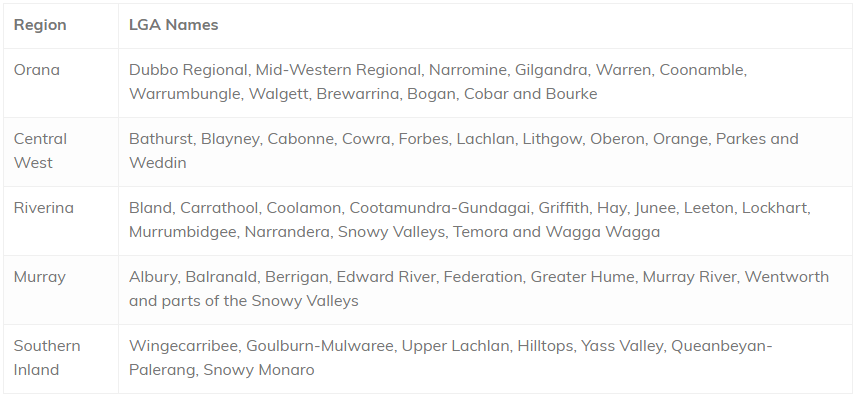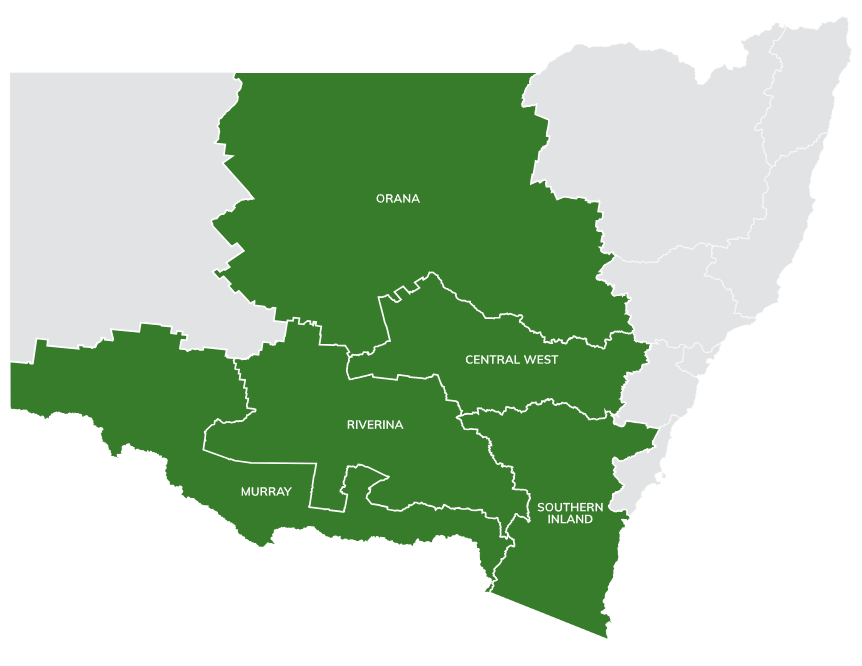What is the Orana DAMA?
The Orana DAMA is an agreement between the RDA Orana and the Federal Government that supports employers in regional areas such as the Orana, Central West, Southern Inland, Murray and Riverina RDA regions.
Regional employers can often struggle with ongoing labour shortages and the DAMA is designed to help them fill critical roles where local workers are unavailable.
Approved employers can sponsor skilled migrants, accessing a range of occupations that may not otherwise be available under the standard migration program. Concessions may also be available for age, salary and English requirements.
What areas are covered?
Eligibility to request an Orana DAMA depends on the Local Government Area (council) in which the employer operates their business.
Employers must be physically operating within the Designated Area. This includes New South Wales’ Orana region but in April 2024 also expanded further to include Central West, Murray, Riverina and Southern Inland.
This table summarises council areas within the Orana, Central West, Riverina, Murray and Southern Inland regions:

Source: https://www.rdaorana.org.au/migration/dama/employer-eligibility
What is the process?
There are several steps an employer must go through to gain access to an Orana DAMA Labour Agreement.
Employers need to:
- Conduct Labour Market Testing, in other words job advertising, for the positions that they have identified skills shortages.
- Work out what their specific region is. There are different RDA Orana DAMA Migration Officers for each of the regions:
- RDA Orana
- RDA Murray
- RDA Riverina
- RDA Central West
- RDA Southern Inland

- Prepare an Endorsement Request (seeking support from the RDA to participate in the Orana DAMA). This involves providing information and supporting documents to demonstrate:
- a genuine need for the requested position(s);
- the employer’s inability to fill those positions from the Australian labour market;
- that equivalent employment conditions will be provided to sponsored workers.
- Arrange a discussion and then lodge their application with a relevant Migration Officer in their region.
- At the initial interview, suitability for endorsement will be discussed. This step can be skipped if the employer is being represented by a migration agent or lawyer.
- RDA Orana DAMA Migration Officer will assess the Endorsement Request and liaise with the employer if further information is needed.
- Having provided endorsement, RDA Orana DAMA Migration Officer will send the completed application package to the RDA Orana DAR for their final assessment.
- After officially approved by the RDA Orana DAR, employers can then submit request for a Labour Agreement to the Department of Home Affairs (Federal Government).
The Orana DAMA Labour Agreements is a five-year agreement. However, the initial allocation of occupations and number of nominations are for the first year only.
In later years (for example Year 2, 3 etc), employers who wish to continue sponsoring workers will need to apply to the RDA Orana DAMA Designated Area Representative for approval of the required occupations and/or nomination numbers.
Occupations available
There are currently 129 occupations available on the Orana DAMA occupation list.
Last updated in April 2024, these cover a wide range of industries to help address regional workforce shortages. Key sectors include:
- Agriculture
- Construction & Trades
- Education
- Healthcare (including Aged/Disability Care)
- Horticulture
- Hospitality & Tourism
- Engineering
- Manufacturing
- Meat Processing
The full occupation list can be found here: https://oranadama.org.au/migration/dama/occupation-list.
Concessions available
Age
Occupations with Skill Level 1-4: up to 55 years old
Occupations with Skill Level 5: up to 50 years old
English
Some eligible occupations may allow applicants to have lower English scores than the standard requirements (unless higher scores are required for registration/licencing).
For 482/494: IELTS overall 5.0 with no minimum in each band
For 186: IELTS overall 5.0 with minimum 4.0 in each band
Permanent residency pathway
All occupations have an available pathway to permanent residency (PR) through the ENS 186 visa, after having living and worked in the Orana region for two years while holding a 482 visa.
Temporary Skilled Migration Income Threshold (TSMIT) / Core Skills Income Threshold (CSIT)
For some occupations employers may also access a reduced salary, that is lower than the standard income threshold set in migration law.
It’s important however to also consider any relevant industrial award and the market salary rate for an equivalent Australian employee working in the same location.
Depending on the occupation, two types of TSMIT/CSIT concessions might be available:
- Annual monetary earnings of 90% of current TSMIT/CSIT (presently set at $76,515)
OR
- Monetary earnings are minimum 90% of current TSMIT/CSIT and non-monetary earnings (such as food and accommodation) are maximum 10% of current TSMIT/CSIT) – resulting in total package that at least equals TSMIT/CSIT




